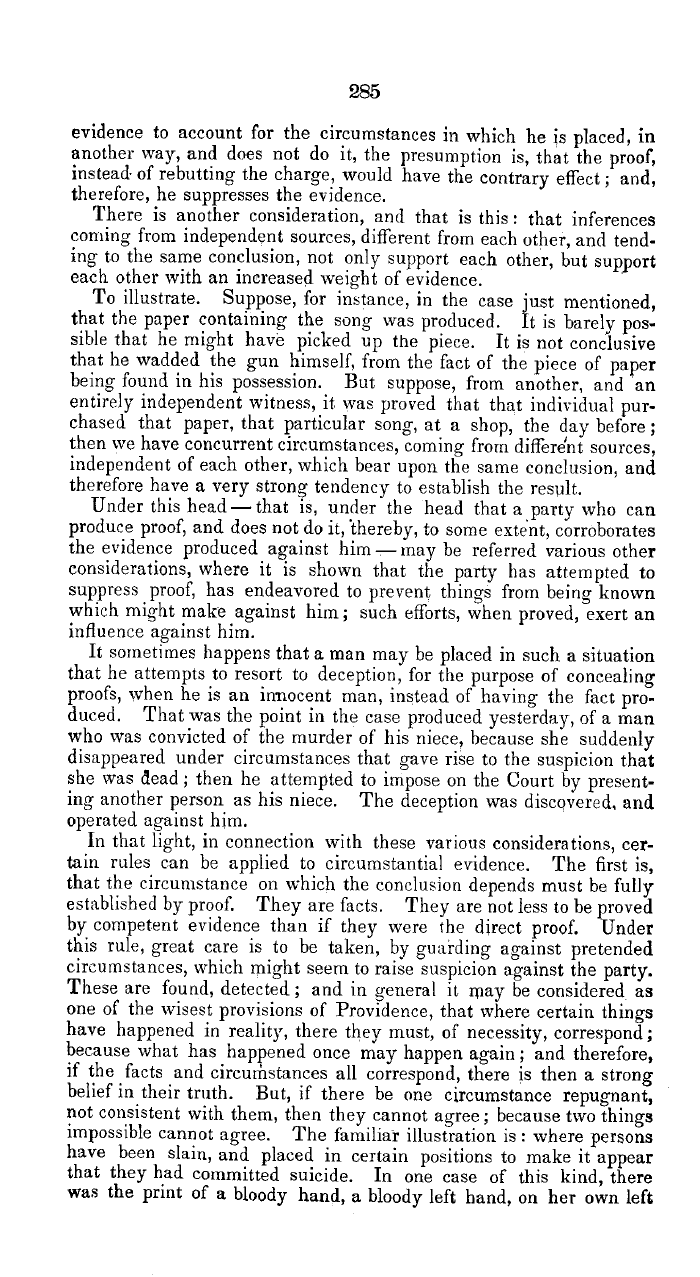|
285
evidence to account for the circumstances in which he is placed, in
another way, and does not do it, the presumption is, that the proof,
instead of rebutting the charge, would have the contrary effect ; and,
therefore, he suppresses the evidence.
There is another consideration, and that is this : that inferences
coming from independent sources, different from each other, and tend-
ing to the same conclusion, not only support each other, but support
each other with an increased weight of evidence.
To illustrate. Suppose, for instance, in the case just mentioned,
that the paper containing the song was produced. It is barely pos-
sible that he might have picked up the piece. It is not conclusive
that he wadded the gun himself, from the fact of the piece of paper
being found in his possession. But suppose, from another, and an
entirely independent witness, it was proved that that individual pur-
chased that paper, that particular song, at a shop, the day before ;
then we have concurrent circumstances, coming from different sources,
independent of each other, which bear upon the same conclusion, and
therefore have a very strong tendency to establish the result.
Under this head-that is, under the head that a,party who can
produce proof, and does not do it, thereby, to some extent, corroborates
the evidence produced against him-may be referred various other
considerations, where it is shown that the party has attempted to
suppress proof, has endeavored to prevent things from being known
which might make against him; such efforts, when proved, exert an
influence against him.
It sometimes happens that a man may be placed in such a situation
that he attempts to resort to deception, for the purpose of concealing
proofs, when he is an innocent man, instead of having the fact pro-
duced. That was the point in the case produced yesterday, of a man
who was convicted of the murder of his niece, because she suddenly
disappeared under circumstances that gave rise to the suspicion that
she was dead ; then he attempted to impose on the Court by present-
ing another person as his niece. The deception was discovered, and
operated against him.
In that light, in connection with these various considerations, cer-
tain rules can be applied to circumstantial evidence. The first is,
that the circumstance on which the conclusion depends must be fully
established by proof. They are facts. They are not less to be proved
by competent evidence than if they were the direct proof. Under
this rule, great care is to be taken, by guarding against pretended
circumstances, which might seem to raise suspicion against the party.
These are found, detected ; and in general it ray be considered as
one of the wisest provisions of Providence, that where certain things
have happened in reality, there they must, of necessity, correspond;
because what has happened once may happen again; and therefore,
if the facts and circumstances all correspond, there is then a strong
belief in their truth. But, if there be one circumstance repugnant,
not consistent with them, then they cannot agree; because two things
impossible cannot agree. The familiar illustration is : where persons
have been slain, and placed in certain positions to make it appear
that they had committed suicide. In one case of this kind, there
was the print of a bloody hand, a bloody left hand, on her own left
|

